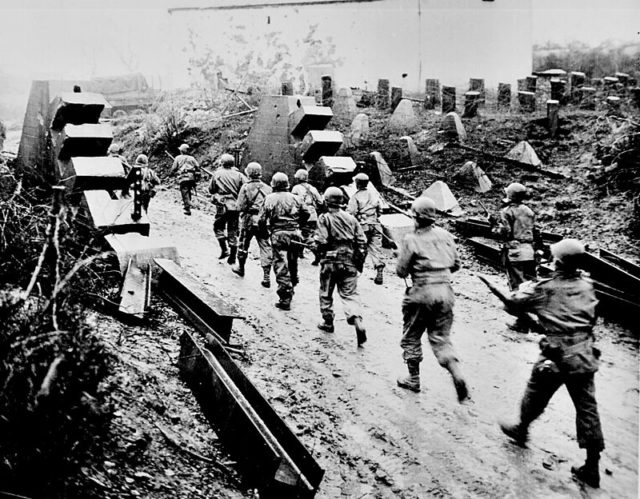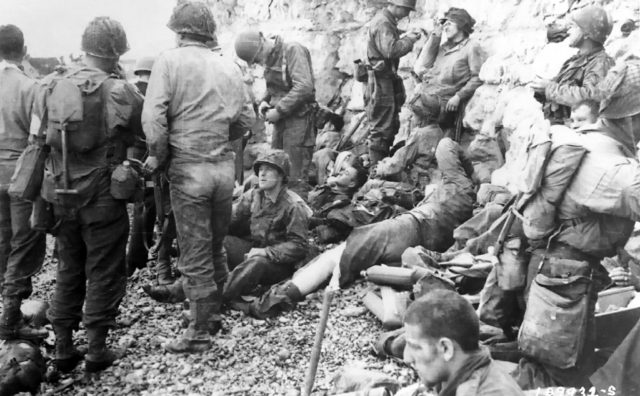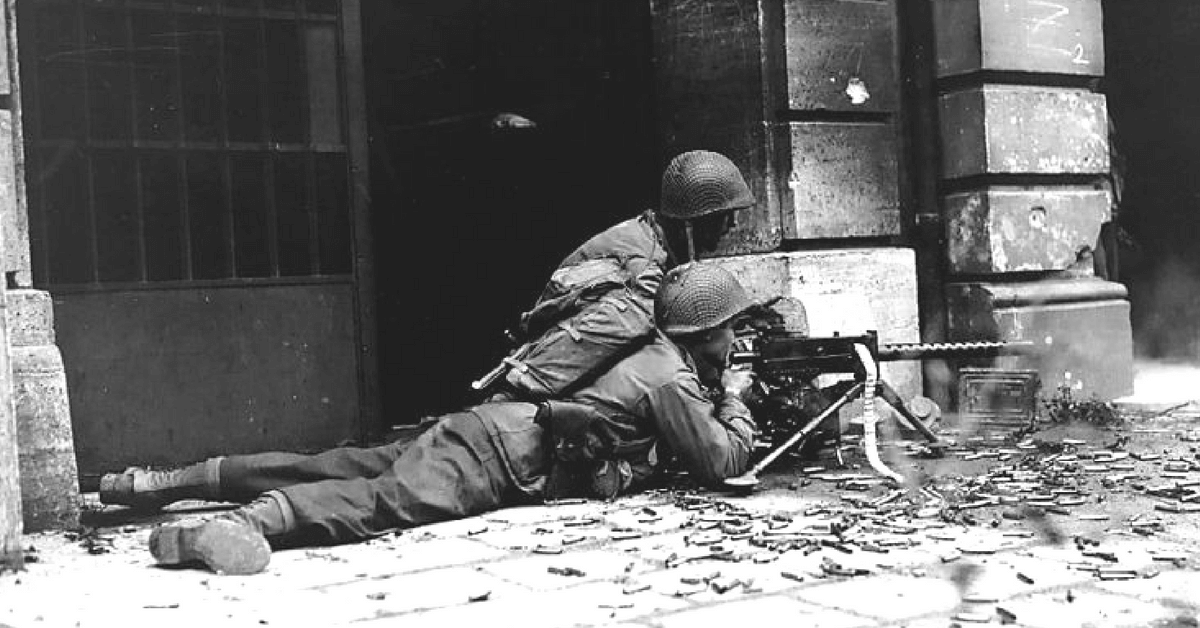On October 8th, 1944, Bobbie Brown did indeed have a prerogative, and that was to single-handedly destroy three German bunkers on a heavily fortified hill near Aachen, Germany.
Enlisting at the age of 15 with the help of a forged document, by the time World War 2 arrived Bobbie Brown was already a 1st Sergeant in Patton’s 2nd Armored Division. As the campaign in Africa ended, Brown was transferred to the 1st Infantry Division where, if his actions are any indication, he still seemed to think he was in a tank. When the dreaded assault up Crucifix Hill began, the now Captain Bobbie Brown quickly found his men pinned down and under extensive fire. Returning to his roots as First Sergeant, Captain Brown quickly decided to go it alone.
Taking the necessary explosives with him on each run, he ordered his men to lay down covering as he on not just one, but three occasions, assaulted the bunkers alone. In each case, he was left standing while a fortification was left smoldering. Despite the wounds he received during this epic action, he would continue to fight and before the day was over would have earned the nation’s highest military honor, for what can only be described as inexplicable gallantry.
Born to Fight
Actually named Robert Brown, Bobbie was born in Dublin, Georgia in 1907 and at the ripe young age of 15 left to join the Army in 1922. When he arrived at the recruiting station, he told the recruiter his name was Bobbie, and for the next 30 years that is how the United States Army would know one of their greatest heroes. Utilizing his superior athletic ability, Brown developed a strong career in Army boxing and football. Having made the all-army team in 1927, he was offered scholarships at three universities before they realized their prime recruit had actually only completed the 7th grade.
When World War 2 broke out for America in 1941, Brown would find himself a 1st Sergeant in one of General George Patton’s famed Divisions. Storming across North Africa with Patton, his competency and willingness to fight would be prized, and he was subsequently offered a battlefield commission to Second Lieutenant. After leading a platoon up Omaha Beach on D-Day, he was given command of a Company after his Company Commander was killed.

Despite already having a career and combat experience worthy of envy, Captain Bobbie Brown’s best would be ahead of him. As part of the 1st Division’s drive to capture Aachen, Germany, Captain Brown’s company would be charged with taking the dreaded position known as Crucifix Hill. With no less than 43 pillboxes and bunkers, Brown’s Company was responsible for taking 7 of them. The resistance was expected to be fierce, and it would require the inexplicable gallantry of an enlisted man turned officer if his men were to walk off that hill alive.
Leading the Way
As the assault on Crucifix Hill began, Brown took his platoon out of their fixed position at a graveyard near the bottom of the hill. Charging with all their might, they made it 150 yards before the withering German fire forced them to take cover or face imminent slaughter. Flanking fire from the surrounding pillboxes began to take its toll, and a barrage of German artillery descended. In an instant, Captain Brown knew if he was to save his men the time for action was now. Immediately, he screamed out “Get me a couple of flamethrowers, some pole and satchel charges.” Armed with his newfound arsenal, Captain Brown headed out alone.

Ordering his men to provide cover fire, Brown crawled forward using every mound of dirt as cover where possible. He eventually landed in an impact crater just short of the first bunker. Identifying an aperture by the door, Brown threw in the first satchel charge, and the bunker erupted into flames and smoke. However, if Captain Brown was to save his men, it would require just a little bit more. Heading back to friendly lines, he loaded up with additional charges and set out for the second bunker. This time, he would have to crawl an additional 35 yards forward past the smoldering first bunker. Arriving, he stuck a pole charge through a slit just 12-inches across. Utilizing the hole blown open by the explosion, he threw in another satchel charge to finish the job as mortars began to land around him.
On his way back down the hill, he noticed blood racing down his leg and one of his men told him that he had been hit. In awe, this group of enlisted men were fully aware their Captain could have ordered them forward was doing the job himself. Rallying the men, they proceeded to one of the most heavily fortified bunkers on the hill, manned by no less than 40 German soldiers and a modified 88mm cannon which could revolve 360 degrees if need be. However, with a stroke of fortune this structure, like every other Captain Brown had encountered, would be laid to ruin.
One More for Good Measure
Making their way to the heavily fortified bunker, Captain Brown approached with two satchel charges just as a German soldier carrying ammunition was heading through the thick steel door. Throwing in both charges, the giant bunker was destroyed, and resistance on Crucifix Hill began to crumble. And yet, Captain Brown was not yet done. Recognizing the threat of counter-attack beyond the hill, Brown proceeded to reconnoiter the lines alone on the other side. Identifying avenues of approach for such an attack, Captain Brown would expose himself to enemy fire in order to identify the enemy gun positions. Despite being wounded twice while basically begging German troops to shoot at him, the enemy positions were identified, and the position would be held.

With complete disregard for his wounds, Captain Bobbie Brown continued to fight on into Aachen. He would eventually be wounded when an artillery shell landed right next to him. After months in the hospital, he recovered only to return to his unit for combat in Czechoslovakia. Shortly after the war ended, he flew home and received his Medal of Honor for actions on Crucifix Hill on August 23rd, 1945. He would have years of hard recovery ahead of him from his dozen plus war wounds, and yet, in 1952, completed 30 years of service with the United States Military.
Sadly, plagued with memories of his enduring conflict and pain from his war injuries, Captain Bobbie Brown died of a self-inflicted gunshot wound in 1971. He had previously taken up a job as a janitor at the United States Military Academy at West Point in keeping with the same lifelong humility which caused a former 1st Sergeant and then Captain to charged up the dreaded Crucifix Hill alone. His actions were in keeping with the best traditions and honor of the United States Military, as well as all those others who earned the nation’s highest military honor.
